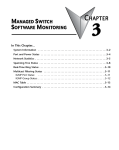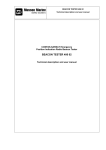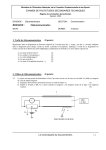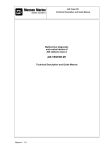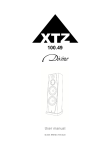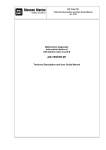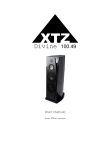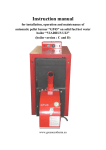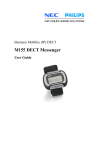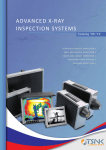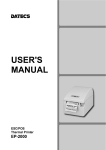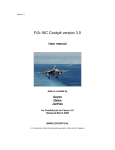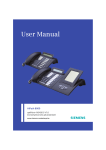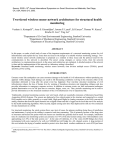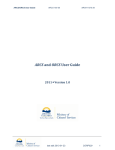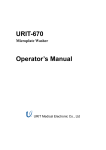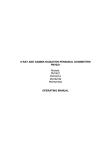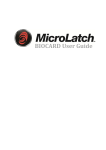Download MF/HF/VHF DSC Marine Radio Test System MRTS
Transcript
MF/HF/VHF DSC Marine Radio Test System (MRTS-7) Technical description and user manual MF/HF/VHF DSC Marine Radio Test System MRTS - 7 Technical description and user manual MF/HF/VHF DSC Marine Radio Test System (MRTS-7) Technical description and user manual Changes indication page Date Signature Internal accompanying document reference number canceled New one Changed or updated Item number Changes Page number Document number Changes indication page page 1 22.01.2007 MF/HF/VHF DSC Marine Radio Test System (MRTS-7) Technical description and user manual Actual content pages Item Page Date Page Date 1 22.01.07 Item 6 Operation guideline 16 12.10.07 Actual content pages 2 22.01.07 Item 7 Tester’s calibration 17 22.01.07 Contents 3 22.01.07 Item 1 Purpose 4 14.01.08 Item 8 Maintenance guideline 18 22.01.07 Item 2 Main features and characteristics 6 Item 9 Storage rules 19 22.01.07 12.10.07 20 14.01.08 8 22.01.07 Appendix 1. Controller software update manual Item 3 Complete set Item 4 Operation 9 22.01.07 Item 5 Preparation for operation and operation procedures 10 29.10.07 Changes indication page Actual content pages Item Page 2 22.01.2007 MF/HF/VHF DSC Marine Radio Test System (MRTS-7) Technical description and user manual CONTENTS Item name Item Page Changes indication page 1 Actual content pages 2 Contents 3 Purpose 1 4-5 Main features and characteristics 2 6-7 Complete set 3 8 Operation 4 9 Preparation for operation and operation procedures 5 10-15 Operation guideline 6 16-16-16 Tester’s calibration 7 17 Maintenance guideline 8 18 Storage rules 9 19 Appendix 1 20 Controller software update manual Contents page 3 22.01.2007 MF/HF/VHF DSC Marine Radio Test System (MRTS-7) Technical description and user manual 1. PURPOSE The MF/HF/VHF DSC Marine Radio Test System MRTS-7 (further tester) is intended to carry out the efficiency, maintenance and servicing tests of the following equipment (under IMO A.948(23) resolution): ● VHF receiver-transmitters: - efficiency tests on 6, 13 and 16 channels; - test of frequency and output power; ● VHF receiver-transmitters with DSC: - test confirming the correctness of the MMSI code programmed in equipment without any broadcast emission; - test of correct transmission/reception of DSC messages by means of transmission/ reception of test message; ● MF/HF radiotelephone equipment : - test of frequency tolerance in range (1600 – 30000) kHz; - efficiency tests by means of transmission line quality and transmitter output power measurements; - efficiency test in all frequency range (1600 – 30000) kHz; ● MF/HF DSC controllers: - test confirming the correctness of the MMSI code programmed in equipment; - test of presence of emergency signal on MF/HF with DSC by means of transmission of DSC Distress message; ● MF/HF receivers monitoring the DSC: - efficiency test by means of transmission of test call; ● NAVTEX equipment : - efficiency test by means of transmission of test message; ● VHF duplex radiotelephony equipment: - efficiency tests on 6, 13 and 16 channels; - frequency tolerance test and frequency deviation estimation; ● VHF equipment of duplex radiotelephony with airplanes including operating on 121.5MHz and 123,1MHz: - frequency and power measurements; ● carried radiophone stations operating in range (300,025-300,225) MHz (intended for river-sea vessels): - frequency and power measurements. The tester is capable to receive the MF/HF/VHF radios emission working in normal mode without any connections by means of telescopic antenna, and transmit the DSC message both by means of telescopic antenna and direct HF cable connection to DSC receiver input. Besides the tester allows to: ● generate the HF signals in range of 0,5 – 200 MHz; ● measure the signals frequency in range 0,1 – 640 MHz. The main view of tester is shown on figure 1-1. Item 1. Page 4 Purpose 22.01.2007 MF/HF/VHF DSC Marine Radio Test System (MRTS-7) Technical description and user manual Figure 1-1. MRTS-7 1.1 The tester is designed to operate in range of + 0оС до + 45оС external environments and 95% relative humidity which is connected with LCD display implementation. 1.2 The tester is power supplied by external 7-10VDC power supply unit, not less 600mA load current. Attention!!! While using exterior power supply unit be careful to pay attention to its right polarity. The power supply units of different manufacturers have opposite polarity of external signal! The polarity of power supply unit should be the same as shown below or indicated on the bottom of tester’s case! 9V DC Item 1. Page 5 Purpose 22.01.2007 MF/HF/VHF DSC Marine Radio Test System (MRTS-7) Technical description and user manual 2. MAIN FEATURES AND CHARACTERISTICS. 2.1 Operational frequencies 2.1.1 DSC operational frequencies in SEND DSC and RECEIVE DSC modes. 2.1.1.1 MF range: 2187,5 kHz – Distress frequency; 2177,0 kHz – Traffic frequency; 2189,5 kHz – Traffic frequency. 2.1.1.2 HF range: Distress frequencies: 4207,5 6312,0 8414,5 12577,0 16804,5 2.1.1.3 VHF range: 2.1.2 Traffic frequencies: kHz kHz kHz kHz kHz 4219,5 6331,0 8436,5 12657,0 16903,0 kHz kHz kHz kHz kHz 156,525 MHz ( ITU : CH 70 ). Frequency range and frequency resolution in HF generation mode : Range, MHz 100 - 200 25 - 100 0.5 - 25 Frequency spacing, kHz 1,0 kHz 1,0 kHz 125 Hz 2.1.3 Stability of output frequencies: ● Frequency setup accuracy at +20°С: not less ±1,0 ppm ; ● Temperature stability of frequency in range of +5 … +45°С: not less ±1,0 ppm ; ● Aging rate : not more ±1,0 ppm/year for first year at +20°С. 2.2 Levels of output signals. 2.2.1 Levels of output signals in SEND DSC mode. 2.2.1.1 NORM. POW mode: ● VHF range : 96 dBmkV ± 1 dB ; ● MF/HF range : 96 dBmkV ± 1 dB . 2.2.1.2 LOW.POW mode: ● VHF range : 40 dBmkV ± 3 dB ; ● MF/HF range : 40 dBmkV ± 3 dB . Item 2. page 6 Main features and characteristics 22.01.2007 MF/HF/VHF DSC Marine Radio Test System (MRTS-7) Technical description and user manual 2.2.2 Levels of output signals in LAB – KIT / RF – OSC mode. F.range, MHz 100 - 200 25 - 100 0.5 2.2.3 2.2.4 2.2.5 25 Output signal level 98 dBmkV ± 1,5 dB 98 dBmkV ± 1,0 dB 98 dBmkV ± 2,0 dB Signal (strength) depression range: 0 - 70 dB Signal (strength) depression setup step: 2 dB Attenuation characteristic deviation* in frequency range of 2-200 MHz: not less ± 1 dB . *) – deviation from rating value. 2.3 Input and output resistances 2.3.1 Resistance of Tx_DSC / OSC output: 2.3.2 Resistance of Rx_DSC input: 2.3.3 Resistance of Freq.Counter input: ● for 0,1 – 45 MHz range : ● for 45 - 640 MHz range : (50 ± 5) Ohm . (50 ± 5) Ohm . (1000± 100) Ohm ; (50 ± 5) Ohm . 2.4 Max and min Level in RECEIVE DSC mode 2.4.1 Maximum signal’s level applied to Rx_DSC input: +20 dBmW /126 dBmkV. 2.4.2 Minimal signal’s level can be determined by DSC decoder : ● for VHF range - 40 dBmW / 66 dBmkV. ● for MH/HF range - 30 dBmW / 77 dBmkV. 2.4.3 linear range of logarithmic measuring instrument of received signal: ● (28 – 100) dBmkV at ± 1,5 dB accuracy 2.5 Tester’s parameters in F_COUNTER – frequency counter mode. 2.5.1 Ranges of frequencies: ● 0,1 – 45 MHz with accuracy ± 90 Hz ● 45 - 640 MHz with accuracy ± 900 Hz 2.5.2 Sensitivity: ● in range ( 0,1 – 50) MHz : -17 dBmW / 31,6 mV / 90 dBmkV ; ● in range ( 50 – 200) MHz : + 2.5 dBmW / 300 mV / 109.5 dBmkV ; ● in range ( 200 – 640) MHz : -7 dBmW / 100 mV / 100 dBmkV; Item 2. page 7 Main features and characteristics 22.01.2007 MF/HF/VHF DSC Marine Radio Test System (MRTS-7) Technical description and user manual 3. COMPLETE SET. 3.1. The complete set of tester includes the items in accordance with table 3-1. Table 3-1 # 1 2 3 4 5 6 Item name MF/HF/VHF Marine Radio Test System (MRTS – 7) Power supply unit Antenna Computer cable, software Technical description and user manual Package Qty 1 Notes 1 1 1 1 1 Issue number: _____________________________________ Issue date: ________________________________________ Acceptance date: ____________________________________ Item 3. page 8 Complete set 22.01.2007 MF/HF/VHF DSC Marine Radio Test System (MRTS-7) Technical description and user manual 4. OPERATION. Tester consists of three main units: receiver unit, generator unit, and controller unit. Receiver unit is intended to receive and demodulate the HF signals of MF/HF/VHF frequency ranges, and also is intended to provide the other units with stabilized voltage and connection to PC. Receiver unit consists of : ● superheterodyne MF/HF range with frequency adjustment – 8814 and demodulator of FSK – signal by means of phase-locked-loop frequency control ; ● superheterodyne VHF range with frequency adjustment – 455 kHZ and FM-detector of counting type ; ● linear voltage stabilizer +10 V – main primary voltage ; ● linear voltage stabilizer +5 V - for controller unit ; ● converter of negative voltage (- 4 V) – to switch the pin – diodes; ● UART – USB bridge. Generator unit is intended to form the output frequency range in SEND DSC , RF – OSC modes and heterodyne frequency for MF/HF/VHF receivers. The unit consists of following main subunits: ● temperature-compensated reference generator 16384 kHz ; ● phase-locked-loop frequency control circuit including the DDS – former of reference frequency; ● 4 VCO that cover (100 – 200) MHz frequency range; ● set of 8 scalers with Кdev = 2 ; ● set of 13 semiactive filters of 7th order with с pin- diode commutators ; ● output wide-range amplifier; ● resistance attenuator with relay commutator; ● serial-parallel counters – instruction receivers from Controller unit. Controller unit is intended to control all tester operation, its connection to PC procedure, to measure the frequency. Controller units consists of: main controller, clock – calendar with lithium battery power supply, FSK – modem for DSC modulation/ demodulation in VHF range, frequency counter, negative voltage converter for LCD, LCD and keyboard. Item 4. page 9 Operation 22.01.2007 MF/HF/VHF DSC Marine Radio Test System (MRTS-7) Technical description and user manual 5. PREPARING FOR OPERATION AND OPERATION PROCEDURES 5.1 General The tester has user-friendly interface. The tester is controlled by means of MENU and 5 independent navigation keys: ↑, ↓, ←, →, Ent and 3 context-dependent keys : MAIN, OK and ESC. The vertical menu navigation is carried out by means of ↑ and ↓ keys; Confirm/choose something by means of Ent and OK, and escape, cancel or move up menu level by means of ESC key. Use the MAIN key to go directly to main menu. After the tester is turned on it displays the device’s model, its serial number, software version and manufacturer. After that it is necessary to push Ent or OK key to enter the main menu. The main menu allows to choose one of following operating modes: ● ● ● ● ● SEND DSC RECEIVE DSC NAVTEX LAB KIT SET UP - Send the DSC messages Receive the DSC messages NAVTEX test message transmission mini-lab: HF-generator, frequency counter; tester’s settings. 5.2 LCD Hightlight The level of LCD highlight can be changed by help of Backlight button, but it can be done only on MAIN menu. There are four levels of LCD highlight (the first – highlight is turned off). The default highlight level – is third. 5.3 The SEND DSC - send the DSC messages In SEND DSC menu user can choose on of following DSC message type to send: ● ● ● ● 5.3.1 TEST TRAFFIC DISTRESS CUSTOM (optional) Menu SEND DSC > DISTRESS DISTRESS - DSC message with format specifier – 112 (DISTRESS), which will be sent on specially dedicated frequencies. This message can be accepted by any maritime and coastal radio stations. Thus it is recommended to send this DSC message inly by means of cable with reduced level taking into account all safety measures to avoid false DISTRESS signal. In this menu the user can choose the operating frequency at first: ● VHF 156,525 MHz ( CH 70 ) ● MF/HF 2 187,5 kHz 4 207,5 kHz Item 5. Preparation for operation and operating procedures page 10 22.01.2007 MF/HF/VHF DSC Marine Radio Test System (MRTS-7) Technical description and user manual 6 312,0 kHz 8 414,5 kHz 12 577,0 kHz 16 804,5 kHz Then the user can set up the power of output signal: ● NORM.POW - The normal (high) level of output signal – recommended while sending by means of antenna. ● LOW .POW - the reduced level of output signal – recommended while sending by means of cable. Menu SEND DSC > TRAFFIC TRAFFIC - DSC message with format specifier – 120 (Individual call) and Category ID – 100 ( Routine ) intended for exact addressee with exact MMSI number on frequencies dedicated for daily radio usage. 5.3.2 First choice – the choice of range and operating frequency: ● MF - 2 177,0 kHz 2 189,5 kHz ● HF - 4 219,5 kHz 6 331,0 kHz 8 436,5 kHz 12 657,0 kHz 16 903,0 kHz Then - the choice of power level of output signal: ● NORM.POW - The normal (high) level of output signal – recommended while sending by means of antenna. ● LOW .POW - the reduced level of output signal – recommended while sending by means of cable. After that the message with chosen parameters and radio-addressee MMSI number are shown on LCD. The MMSI number can be changed in SET UP menu if it’s required. ATTENTION: It is necessary to specify (input) the correct MMSI number of tested radio station to provide the reception of the DSC message of Individual call format. Otherwise the message will sent but will not be received by this station! Menu SEND DSC > TEST TEST - DSC message with format specifier – 120 (Individual call) Category ID – 108 (Safety), intended for exact addressee with exact MMSI number on DISTRESS frequencies. Thus this message is very useful to test the DSC radio stations on DISTRESS frequencies without any risks of false emergency alerts. 5.3.3 As in previous cases the have to choose the operating frequency: ● VHF 156,525 MHz ( CH 70 ) ● MF/HF 2 187,5 kHz 4 207,5 kHz 6 312,0 kHz Item 5. Preparation for operation and operating procedures page 11 22.01.2007 MF/HF/VHF DSC Marine Radio Test System (MRTS-7) Technical description and user manual 8 414,5 kHz 12 577,0 kHz 16 804,5 kHz Then - to choose the power level of output signal:: ● NORM.POW - The normal (high) level of output signal – recommended while sending by means of antenna. ● LOW .POW - the reduced level of output signal – recommended while sending by means of cable. ATTENTION: It is necessary to specify (input) the correct MMSI number of tested radio station to provide the reception of the DSC message of Individual call format. Otherwise the message will sent but will not be received by this station! 5.4 Menu RECEIVE DSC - Receive the DSC messages In RECEIVE DSC mode tester receive and decode DSC message in DISTRESS ( 112 ) и INDIVIDUAL CALL ( 120 ) formats; the messages of other formats are not to be decoded as the tester is not the DSC receiver station and intended only to check the operation of DSC equipment. First of all it is necessary to set up (choose) the range and operating frequency from the set or the DISTRESS frequency. ● VHF - 156,525 MHz ( CH 70 ) ● HF - DISTRESS :…… 4 207,5 kHz 6 312,0 kHz 8 414,5 kHz 12 577,0 kHz 16 804,5 kHz TRAFIC :………………. 4 219,5 kHz 6 331,0 kHz 8 436,5 kHz 12 657,0 kHz 16 903,0 kHz ● MF - DISTRESS : 2 187,5 kHz TRAFIC : 2 177,0 kHz 2 189,5 kHz After the frequency is chosen tester goes to received mode (waiting for message) and displays: WAITING FOR A SIGNAL . When the tester detects coming DSC message it gives the sound alert. After the message is received the tester will display on LCD the decoded information, also the received and calculated checksum (ECC) and power level are displayed too. The received data such as the signal power level, operating frequency, date and time of tests, message contents can be saved by pressing the SAVE key of contextual menu. If you would like to escape the waiting mode manually just press one of the Ent, OK, MAIN or ESC keys. Item 5. Preparation for operation and operating procedures page 12 22.01.2007 MF/HF/VHF DSC Marine Radio Test System (MRTS-7) Technical description and user manual 5.5 Menu LAB-KIT - mini-laboratory In LAB-KIT mode the following instrument can be chosen: ● RF – OSC - HF signal generator ; ● F – COUNTER - Frequency counter. ● DEVIATION - frequency deviation measurement on 6, 13, 16 and 70th channels of VHF range. 5.5.1 Menu LAB-KIT > RF – OSC In LAB-KIT > RF – OSC mode the tester becomes the multi-purpose HF generato. The first user choice – frequency range setup: ● 100 – 200 MHz - frequency tuning step – 1 kHz ; ● 25 – 100 MHz - frequency tuning step – 1 kHz ; ● 2 – 25 MHz . - frequency tuning step – 125 Гц ; Then the operating frequency can be setup by means of digital keypad: the number position can be changes by moving of the lower cursor by means of ← and → keys. Use the context-dependent keys - DF and +DF (Delta Frequency) to change up or down the frequency by minimal allowed frequency tuning step for this range. The last used frequency will be saved in memory after leaving the range to other menu and will be setup automatically when this range is chosen again. The last used frequency meanings of all three ranges will be saved in memory until the tester is turned on. The level of output signal can be setup by means of ↑ (Up) or ↓ (Down) keays in range of minimal ( 0 dB ) and maximal (-70 dB) meaning by step of 2 dB . 5.5.2 Menu LAB-KIT > F-COUNTER The LAB-KIT > F-COUNTER mode is the multi-purpose frequency counter which is capable to measure the frequency in range of 100 kHz to 640 MHz from separate input: Freq. Counter. Two frequency ranges can be chosen: ● 0,1 - 45 MHz ● 45 - 640 MHz Or self-test SELF TEST mode which is intended to measure the frequency of built-in high-stable temperature-compensated TCXO oscillator. The meaning of (16 384 000 ± 2) Hz is correct and indicates normal conditions. After the frequency range is chosen press the Ent key to start the measurements; each further key will show the next new measurement. Measurement interval time - 0,1 second. 5.5.3 Menu LAB-KIT > DEVIATION This mode allows to measure the frequency deviation in VHF range on following channels: : CH-06 156,300 MHz Item 5. Preparation for operation and operating procedures page 13 22.01.2007 MF/HF/VHF DSC Marine Radio Test System (MRTS-7) Technical description and user manual CH-13 156,650 MHz CH-16 156,800 MHz CH-70 156,525 MHz. The measurements are carried out in automatic mode; the deviation meaning (DEV) and received signal level (RSSI) are displayed on LCD. The deviation measurement range is limited by pass band of phase-locked-loop frequency control and can not be more then 7kHz. At signal level of 100* mkV / 40 dBuV the frequency detector is overloaded by noises and the deviation meaning tends to maximum (6,9…7.0 kHz), this should be taken into account during measurements. 5.6 Menu SET UP - tester’s setting In SET UP menu the following parameters can be setup: ● SELF TEST - self-test of tester; ● EDIT MMSI - edit the MMSI number of radio station addressee. It is important that this number is equal to MMSI number of radio station to be checked by sending of DSC messages of Individual call ( TEST и TRAFIC) format; ● PC LINK - provides the connection to PC. 5.6.1 Menu SET UP > PC LINK The tester can be connected to PC USB port by means of integral bridge USB – UART (USB Serial Converter) FTDI - FT232R. The freeware soft distributed by FTDI will create virtual COM-port to establish the connection with device. Thus it is necessary to install the software and FT232R drivers on your computer. Attention: All drivers etc can be found at our website: www.gmdsstesters.com in Download section. Software includes: ■ MRTS7_software – ZIP archive of original developer software distributive. ■ CDM 2.00.00 – folder with FT232R drivers; ■ Windows_XP_Installation_Guide – the detailes step-by-step driver’s installation manual. The recommended installation order as follows: 1. Unzip the archive to any folder on a hard disk. 2. Run the MRTS-7 software vX.X. 3. Connect the tester and the PC by means of USB cable available in standard compete set and turn on the power. 4. PC will show the message that new USB device was and will to setup the drivers. Choose the exact folder and set the path to CDM 2.00.00 folder 5. Enter the tester’s menu SET UP > PC LINK and press the button Download data in MRTS-7 software . 6. In the appeared Download data window choose the Init Port and then - COMX, where X- is number of emulated COM-port (usually in range of 3.11). The push the Download button. The data transfer will be started. 7. After the data is received it can be viewed by means of green arrows at the right top of software window. Item 5. Preparation for operation and operating procedures page 14 22.01.2007 MF/HF/VHF DSC Marine Radio Test System (MRTS-7) Technical description and user manual 5.7 Menu NAVTEX – transmission of the NAVTEX test message First of all, it necessary to choose the one of three frequencies intended for usage by NAVTEX system: ● 518,0 kHz ● 490,0 kHz ● 4209,5 kHz Then choose the signal’s power and transmit the message: DD HH MM UTC SEP 07 (DD-current date, HH MM –current time) TEST FROM MRTS-7 NNNN The message is transmitted with ID = CDXX identifier, where the XX – number from 00 to 99, increased every time the message transmitted. After the tester is powered off the number is set to 00. Item 5. Preparation for operation and operating procedures page 15 22.01.2007 MF/HF/VHF DSC Marine Radio Test System (MRTS-7) Technical description and user manual 6. Operation guideline 6.1 Tester’s self-test 6.2 Send the DSC message of DISTRESS format on MF/HF/VHF See picture 6.1. Attention ! During the tests of DSC radio station be careful and pay attention to avoid the false emergency alert signals emission! Thus in SEND DSC > DISTRESS mode it is strongly recommended to connect the tester by means of cable and choose the minimal power level of transmitted signal (LOW.POW). MF/HF/VHF DSC Marine Radio Test System (MRTS-7) Back Light 7 8 9 F1 4 5 6 F2 1 2 3 F3 0 Ent Tx DSC / Osc COAX ANT GMDSS Transceiver Rx DSC < < < Freq. Counter Picture 6.1 6.3 Send the DSC messages of Individual call format See picture 6.2. During the tests by Individual call format message it is important that correct MMSI number of addressee station is specified. Use the EDIT MMSI menu SET UP to specify the required number. Then choose the SEND DSC, TEST or TRAFIC, required frequency and normal power level of signal. Be sure that the whip antenna of tester is in direct visibility of vessel receiver antenna before send the HF-message. It is recommended to connect the counterpoise earth in MF/HF ranges, for example ground connection, or use the antenna in the form of wire circle connected between HFoutput (Tx DSC/OSC) and tester’s case. Item 6. page 16 Operation guideline 22.01.2007 MF/HF/VHF DSC Marine Radio Test System (MRTS-7) Technical description and user manual MF/HF/VHF DSC Marine Radio Test System (MRTS-7) Back Light 7 8 9 F1 4 5 6 F2 1 2 3 F3 0 Ent Tx DSC / Osc ANT GMDSS Transceiver Rx DSC < < < Freq. Counter Picture 6.2 Receive the DSC messages. 6.4 See picture 6.3. In RECEIVE DSC mode tester receives messages from any MMSI number. Thus it is recommended to use the MMSI number of sending radio station or one of follows MMSI numbers: 999 999 999 or 201 999 999 (201 – Albania) to avoid the disturbing of any GMDSS system participants. Be sure the RECEIVE DSC mode is chosen and required frequency is setup before send the signal from test station. Be sure that the whip antenna of tester is in direct visibility of vessel receiver antenna before send the HF-message. ATTENTION ! The tester can receive the DSC messages of DISTRESS format, but use message format to test the station only in absolute necessity cases as it is very difficult to avoid the reception of false emergency signal by other stations. Even equivalent load will not help taking into account the hundred watt power level of emitted signal and mkV stations receiver sensitivity! Item 6. page 16 Operation guideline 22.01.2007 MF/HF/VHF DSC Marine Radio Test System (MRTS-7) Technical description and user manual MF/HF/VHF DSC Marine Radio Test System (MRTS-7) Back Light 7 8 9 F1 4 5 6 F2 1 2 3 F3 0 Ent Tx DSC / Osc ANT GMDSS Transceiver Rx DSC < < < Freq. Counter Picture 6.3 6.5 Tester’s operation in HF-generator mode / RF - OSC The output of HF generator is - Tx DSC / OSC . The own output frequency and heterodynes frequencies in DSC receive mode can be measured by FREQUENCY COUNTER. It is due to the last frequency and output level are saved after escaping the FR-OSC menu. They saved until the next change of frequency in SEND DSC or RECEIVE DSC modes. 6.6 Tester’s operation in FREQUENCY COUNTER mode / F - Counter The input of Frequency counter is Freq.Counter . The input resistances of frequency counter: 0,1 – 45 MHz range: 1000 Ohm, 45 – 512 MHz range: 50 Ohm. Item 6. page 16 Operation guideline 22.01.2007 MF/HF/VHF DSC Marine Radio Test System (MRTS-7) Technical description and user manual 7. Tester’s calibration The tester is a complex special-use electric device. Thus it is should be calibrated only by manufacturer by means of corresponding equipment. The tester should be calibrated every two years Date of next calibration: _____________________________________ Item 7. page 17 Tester’s calibration 22.01.2007 MF/HF/VHF DSC Marine Radio Test System (MRTS-7) Technical description and user manual 8. Maintenance guideline It is necessary to keep the device in package not less then for two hours at normal conditions when it was at high temperature deviation. Keep it the package in at normal condition within 12 hours after storage of the tester in conditions of high humidity. Item 8. page 18 Maintenance guideline 22.01.2007 MF/HF/VHF DSC Marine Radio Test System (MRTS-7) Technical description and user manual 9. Storage rules. The device should be stored in package in warehouse locations defending it from effect of atmospheric precipitation. Temperature in warehouse should be ensured from 278 K (5 С) up to 313K (40 about С) and relative humidity of air no more than 80%. Item 9. page 19 Storage rules 22.01.2007 MF/HF/VHF DSC Marine Radio Test System (MRTS-7) Technical description and user manual Appendix 1. MRTS-7 controller software update. It is necessary to install the FT232R drivers on PC before update the software – see item 5.6.1. Also you should have the software update package including communication program intended to load the object code from PC to controller be means of USB connection cable and HEX-file – the object code should be loaded. The software package is distributed by manufacturer. The step-by-step update manual: 1. Connect the tester to PC by means of issued USB – cable. 2. Turn on the tester and DO NOT PRESS ANY KEYS AFTER as only in this mode the BOOT LOADER is still running providing the object code loading to controller. 3. Run the Update_Sotf software from the package and choose the necessary virtual COM—port. After that the data will be loaded automatically. 4. After loading is finished – close the software window, turn off the tester, and disconnect the USB cable. 5. Power on the tester and ensure that the controller’s software was updated. 6. The emergency MRTS-7 software update instructions: If the tester can not be turned on by usual means of keys, it is necessary to: - connect the tester to PC by means of USB-cable; - press the F3 button and keeping it pressed power on the tester; - Still keeping pressed the F3 button, after 7-10 seconds the tester was powered on: run the Update_Sotf (this delay is necessary to find the FTDI USB converter by PC); then choose the virtual COM-port and after the object code is loaded release the F3 button. The pressed F3 button keeps the controller in stand-by load/update mode and BootLoader placed in protected memory areas is activated. Attention: All drivers etc can be found at our website: www.gmdsstesters.com in Download section. Item 9. page 20 Storage rules 22.01.2007























